B2B SaaS SEO Mastery
10 Ways to Craft an Unbeatable SEO Strategy
In today's dynamic and competitive business landscape, getting noticed is more challenging than ever. This rings true, especially for B2B SaaS SEO companies, who are vying for the attention of a limited and highly specific audience.
Enter SEO—Search Engine Optimisation—the cornerstone of modern marketing strategy.
SEO is no longer a luxury: it's necessary for businesses aiming to reach their full potential online. While consumer-facing (B2C) companies have quickly adapted SEO strategies, their B2B counterparts, particularly in the SaaS industry, are just starting to fully grasp its power and potential.
So, if you're a marketing manager at a SaaS or Technology firm, navigating the labyrinth of SEO, might seem daunting.
But fear not!
In this comprehensive guide, we'll dive into ten essential steps to craft an unbeatable SEO strategy to help you outperform competitors, improve search visibility, and drive growth for your SaaS business.
1: Advanced Keyword Research for B2B SaaS Organisations
Keyword research is the cornerstone of any successful SEO strategy, but the stakes are even higher when it comes to B2B SaaS SEO. The buying process in B2B scenarios is often more complicated and involves multiple stakeholders.
Therefore, it's imperative to conduct advanced keyword research that considers individual keywords and the intricacies of the B2B sales cycle, problem-solving, and user intent.
The Core Dimensions of B2B SaaS Keyword Research
Buyer Personas: In a B2B setting, you're not catering to just one persona. Different stakeholders, such as C-level executives, managers, and technical specialists, might influence the buying decision. Research and identify the keywords that each of these personas might use.
Initial Data Gathering: use tools like Google Keyword Planner, SEMrush, or Ahrefs to compile an exhaustive list of potential keywords. Remember to also analyse your competitor's keywords directly by researching their websites.
Keyword Categorisation: divide your keywords into categories based on buyer personas, search intent, and funnel stage. This will help you create targeted content strategies.
Competitive Analysis: for each categorised keyword, study the competition. Look at the domain authority of competing websites and evaluate how hard it would be to rank for each term.
Search Intent: B2B keywords often include research, comparison, and purchase. This could range from 'best CRM software for small business' (comparison intent) to 'Salesforce pricing plans' (purchase intent).
Keyword Prioritisation: prioritise your keywords based on relevance, search volume, and difficulty. The ideal keyword has high relevance, high search volume, and low competition.
Problem-Solution Mapping: B2B SaaS products usually aim to solve complex problems. Use keyword research to identify your prospects' specific issues and then map these to solution-oriented keywords, like 'how to automate invoicing'.
Long-Tail Keywords: In B2B SaaS, competition for broad keywords is fierce. Long-tail keywords, such as 'cloud-based inventory management for e-commerce', can be easier to rank and are more likely to attract highly qualified leads.
Performance Tracking: implement tracking metrics like Google Analytics to monitor your chosen keywords' performance over time. This enables iterative refinement of your keyword strategy.
Real-Time Adjustments: advanced keyword research is not a one-off task – it's an evolving process. Continuously monitor performance metrics and be ready to pivot your strategy according to changes in search algorithms, market trends, or customer behaviour.
By adopting a multi-dimensional and dynamic approach to keyword research, B2B SaaS SEO organisations can improve their SERP rankings and attract the right kind of traffic—professionals who have both the intent and the authority to buy.
2: Conducting Competitor Analysis
Why it Matters:
Understanding your competitive landscape is essential for crafting an effective SEO strategy.
For B2B SaaS SEO companies fighting for visibility in crowded markets, SEO competitor analysis and SERPs (Search Engine Results Pages) review can provide invaluable insights.
How to Do It:
Identify Core Competitors
Direct vs. Indirect: classify your competitors into those offering similar services and those indirectly competing.
Market Positioning: examine their market positioning and target audience to gauge whether they attract similar buyer personas.
3: SERPs Review for Scaling B2B SaaS
SERPs Review
Keyword Analysis: pinpoint the keywords your competitors rank for and their SERP positions.
Ad Presence: note if competitors use paid ads for the same keywords. Analyse their ad copy and landing pages.
Featured Snippets: keep track of competitors who secure the 'Position Zero' and scrutinise how they did it.
Analyse Website & Content
Technical SEO: inspect their site structure, loading speed, mobile optimisation, and other technical elements.
Content Types: look at the types of content they produce, such as blog posts, eBooks, or webinars, and how they link them together.
Content Depth: assess the thoroughness of your competitors’ content. Are they just scratching the surface or going in-depth? How many words have the produced in the core topics? How many words have they written on core ranking pages? How engaging is this content?
Content Freshness: check how often they update old posts and produce new content.
Content Relevance: gauge how closely their content aligns with user intent and pain points.
Content Structure: review their use of headings, bullet points, and visual elements. See if the content is easily scannable and enjoyable to read.
Content Metrics: consider metrics like social shares, engagement rate, and backlinks to measure content effectiveness.
Backlink Profile
Quality & Quantity: use tools like Ahrefs or SEM Rush to gauge the strength and number of backlinks your competitors possess and their domain authority.
Anchor Text: analyse the distribution of anchor text to infer their keyword targeting strategies.
Monitoring and Reporting
Monthly SERP Tracking: document changes in keyword rankings for both you and your competitors.
Quarterly Reports: incorporate competitor performance metrics to reveal areas of opportunity or caution.
Leverage Competitive Insights
Gap Analysis: identify opportunities or shortcomings in your current SEO strategy based on competitor data.
Strategic Adjustments: apply the insights gleaned to refine your keyword, content, and backlink strategies.
By incorporating a rigorous content analysis in your SEO competitor evaluation, you can pinpoint exactly what makes your competitors' content successful and identify areas for improvement.
This rounded view can be your ticket to crafting content that ranks and resonates better with your target audience, thus driving more meaningful engagement and conversions for your B2B SaaS SEO business.
Here is an example of the term ‘Instagram Marketing'
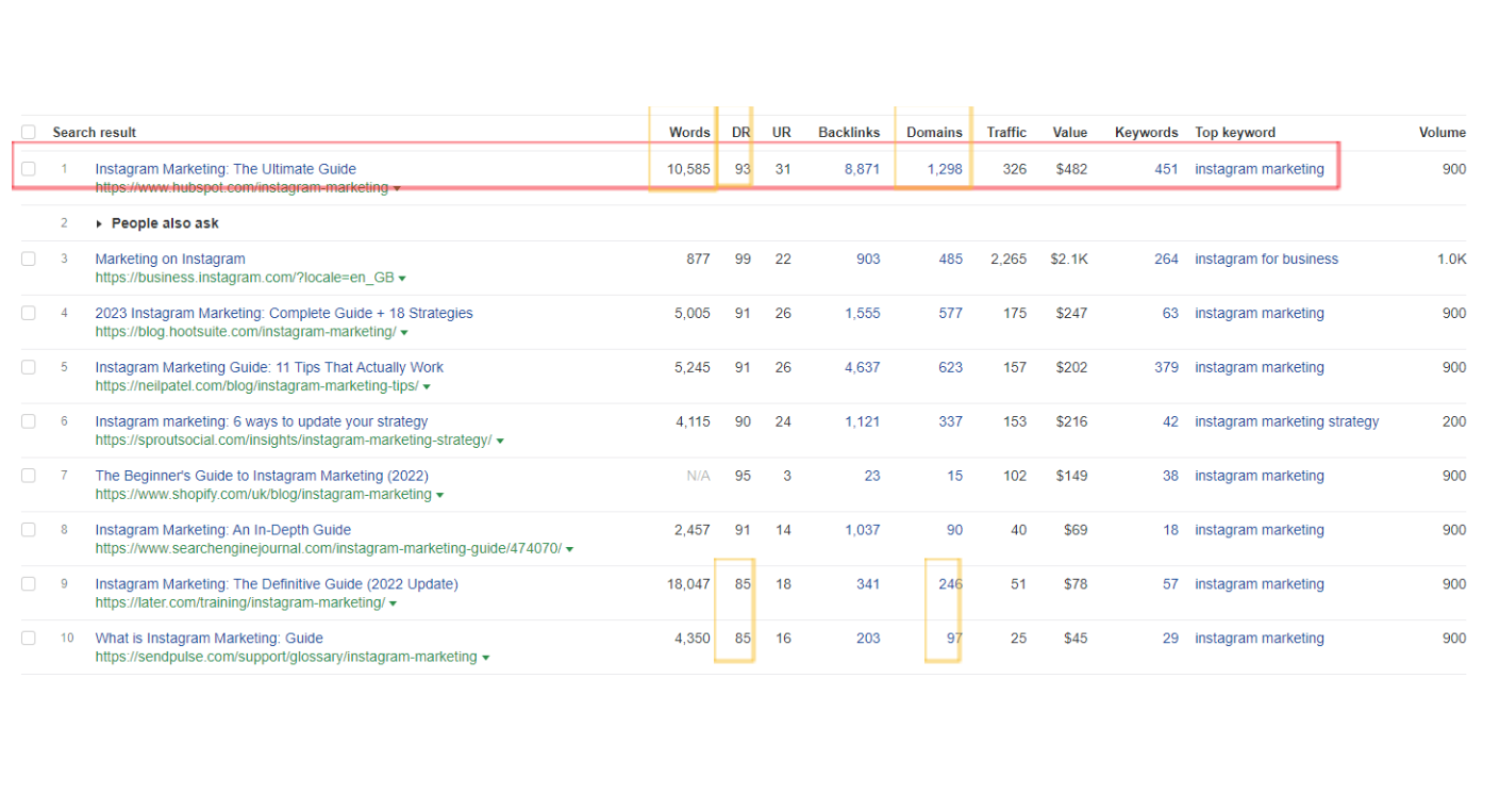
From this, we can learn that HubSpot is the top-ranking website for this term with competition, including Hootsuite and Shopify.
Suppose we want to rank for this page. In that case, we will need to produce at least 10,000 words of premium content, have a powerful website with a domain rating score of over 85 (AhRefs), have a solid amount of highly authoritative domains referring back to the page, likely at least 100 high domain authority websites linking back.
Further analysis would be required to assess the links' authentic quality and authority back to the page.
You can apply this method to your top keyword targets and learn new ones as you analyse the top-performing competitor's website traffic and ranking status.
Need more time? Need the software? Need the knowledge in-house? Angelfish can help you to plan.
4: Crafting High-Quality Content for B2B SaaS Growth
Why it Matters:
In the B2B SaaS SEO ecosystem, content is more than just king; it's the royal court, influencing visibility, credibility, engagement, and conversions.
High-quality content answers complex questions, solves niche problems and serves the varied intents of different stakeholders involved in the B2B buying process.
Google and other search engines favour such content, making it imperative for SEO success.
Key Content Types and Execution Strategies:
Blog Posts
Why: Blogs serve as an entry point for potential clients. They can be optimised for keywords that your target audience is actively searching for.
How: Produce comprehensive, well-researched blog posts that are directly related to your target keywords. For instance, if you offer a project management tool, a blog post about "How to Choose the Best Project Management Software" could be very beneficial.
User Guides & Tutorials
Why: Practical guides and tutorials build trust and can directly assist in product onboarding and feature adoption.
How: Create a repository of how-to guides, video tutorials, and FAQs that address common challenges your customers face. These not only improve user experience but also contribute to long-tail keyword optimisation.
Case Studies
Why: Case studies are compelling sales tools that showcase real-world applications and outcomes.
How: Document how your SaaS solutions have solved specific problems for various types of businesses. Include quantifiable metrics for added credibility.
Regular Content Updates
Why: Fresh, updated content is favoured by search engines and helps maintain or improve your rankings over time. Updating old blogs can also be a very cost-effective way of squeezing more value out of your content budget.
How: Regularly revisit and update your existing content. Remove outdated information and incorporate new findings, best practices, or features.
These content types enable you to add significant depth to your SaaS website. You can go deeper on solving your customer’s problems, evidence your expertise, gain credibility and show your power vs. the competition by producing unbeatable content that Google will want to serve at the top of the pile.
Learn from the Best: HubSpot’s Topic Cluster SEO Technique
HubSpot is a shining example of using topic clusters for SEO to dominate the SaaS industry. Here's how they do it:
Topic Cluster Model: HubSpot focuses on creating pillar content that serves as the main hub for a specific topic. Surrounding this are related articles, or "cluster content," that delve deeper into specific aspects of that topic.
Internal Linking: the pillar content and cluster articles are internally linked, creating a tightly knit topic cluster as demonstrated in the graphic below. This signals to search engines that the pillar page is an authority on the topic.
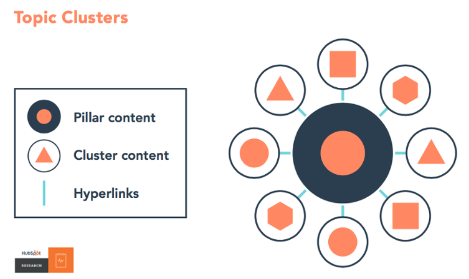
When HubSpot uses this at scale to cover their core topics, it looks like the below structure, but of course, this now spans across thousands of articles and highly detailed topic clusters:
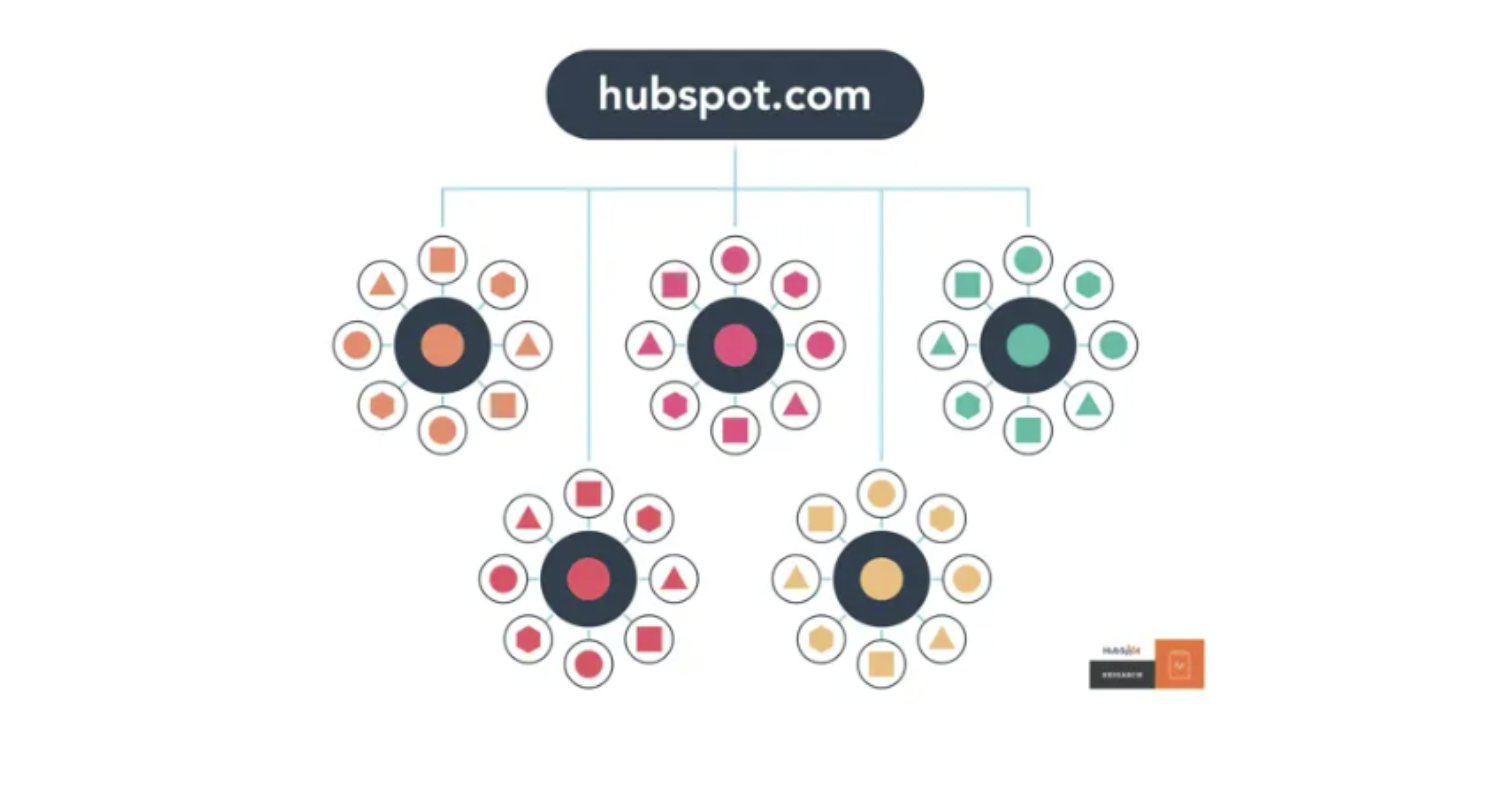
HubSpot is truly the B2B SaaS master of this SEO technique and has built its business from a scrappy startup to a $2 billion market leader using this method.
Here is an example of one of their topic clusters in action:
The keyword primary target: ‘Instagram Marketing’
Global search volume: 1,300 searches per month
Pillar page created: https://www.hubspot.com/instagram-marketing
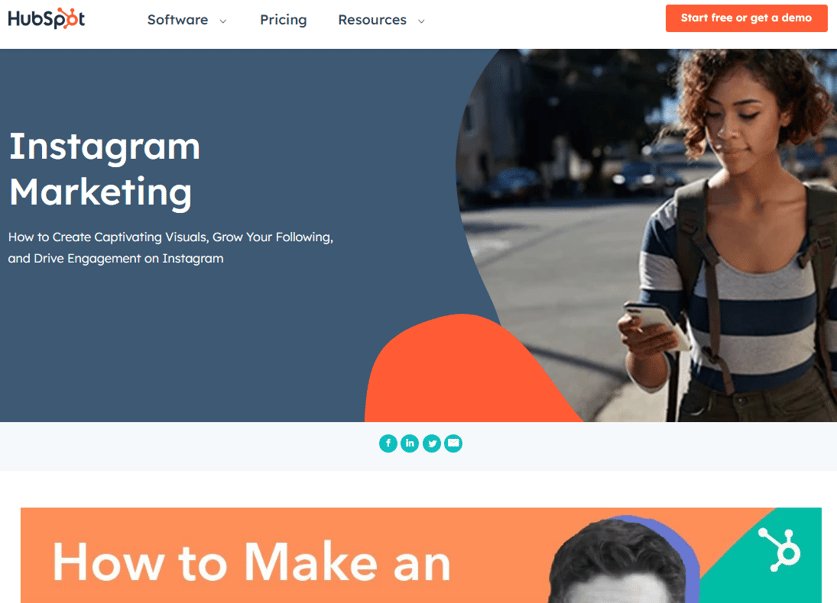
The Ultimate Guide to Instagram Marketing that HubSpot created to target this keyword is a 10,000-word pillar page with images, examples, a guide, video embeds, and CTA's in the page to ensure it is highly engaging and highly valuable for the target visitor.
Results:
- Ranking number 1 for the term ‘instagram marketing’
- 1,100 referring domains to the page
- Ranking for over 6000 keywords on this page
- At its peak times, it has ranked for over 10,000 keywords
- Estimated 7,400 visits per month to the page
This is so powerful that in the UK they currently rank above Instagram for this term:
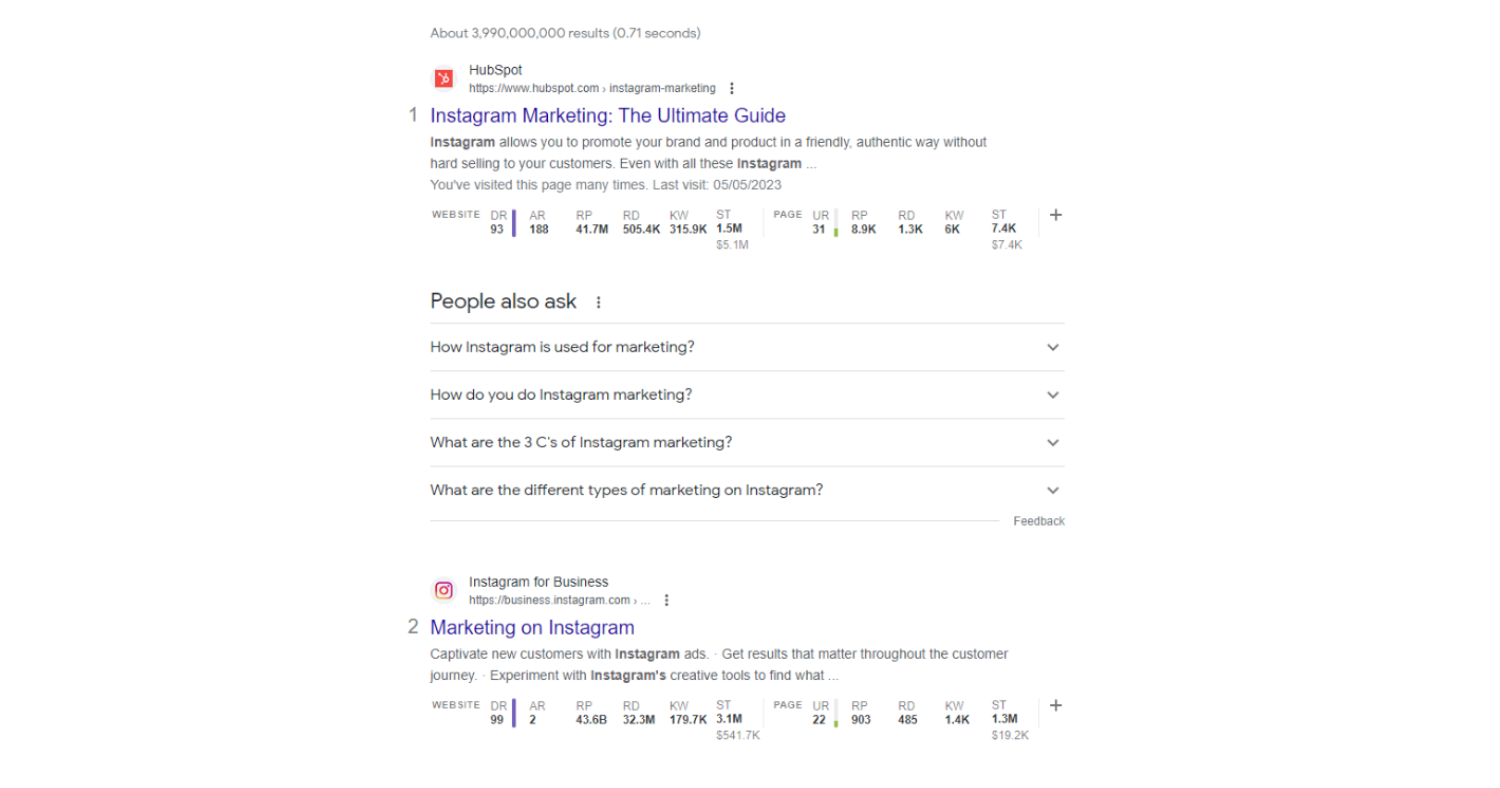
Over the years, HubSpot has seen consistent growth in organic traffic, with a significant portion attributed to its topic cluster strategy. According to SimilarWeb, their website traffic increased from around 23 million in 2017 to over 40 million in 2021.
Currently, HubSpot’s website is ranking for over 300,000 keywords with an organic traffic value (what it would cost you to pay to advertise on these positions) estimated at over $60m per year, showcasing the power of high-quality, well-structured content.
Takeaways:
By integrating topic clusters into your content strategy like HubSpot, and focusing on the four key content types outlined above, B2B SaaS SEO companies can scale their organic growth and offer tangible value to their potential and existing customer base.
If you’re still not convinced, here’s another example of a monster B2B SaaS organisation, Atlassian, implementing this technique with great success:
Atlassian has organised its content into topic clusters that center around "Agile Project Management." Cluster pages include various aspects of agile methodologies, best practices, tools, and case studies.
The keyword primary target: ‘agile project management’
Global search volume: 54,000 searches per month
Pillar page created: https://www.atlassian.com/agile/project-management
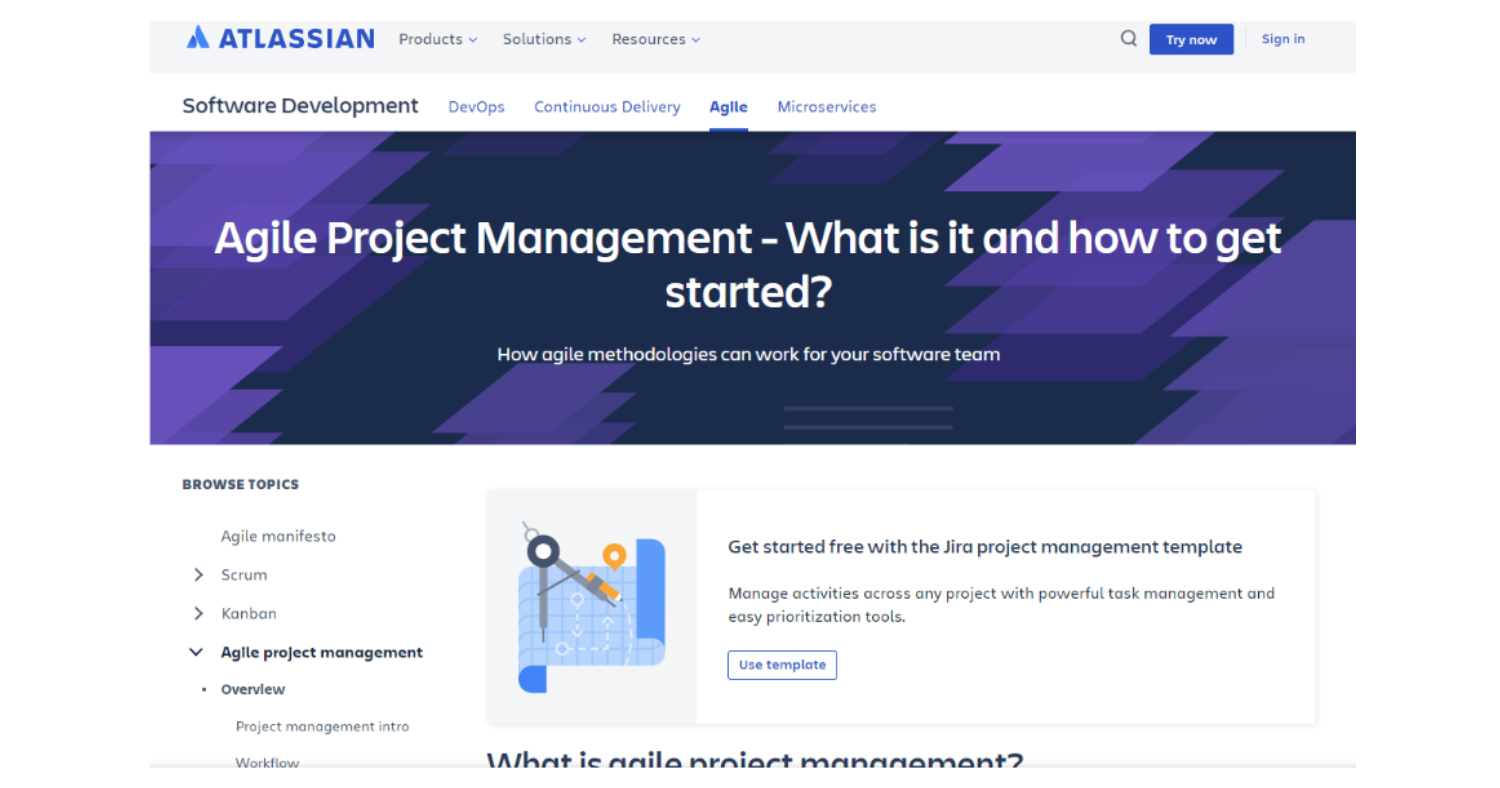
Agile Project Management – What is it and how to get started?
Atlassian has created a 3000+ word pillar page + acquired 1,400 referring domains to the page
Images, examples, guides, and CTAs are all included on the page to ensure it is highly engaging.
Results:
- Ranking number 5 for the term ‘agile project management’ above Asana, Service Now and other core competitors
- Ranking for over 1000 keywords on this page
- Estimated 14,100 visits per month to the page
Of course, these are well-funded companies with huge marketing budgets resulting in very high Domain Authority ratings for the sites. However, this is all relative to your target market, your competition, and the types of keywords you are targeting.
During your competitor review, consider the domain authority and link power of your competition and set your expectations realistically from the start, one topic cluster at a time!
5: Mastering On-Page SEO for B2B SaaS Companies
Why It Matters:
On-Page SEO is crucial for B2B SaaS businesses for multiple reasons. First, it directly influences your page's visibility on search engines. Second, it impacts user experience and engagement, which indirectly affects SEO. Lastly, effective On-Page SEO can guide multiple stakeholders—whether they're CTOs, procurement managers, or end-users—through the complex B2B sales research funnel, ultimately driving conversions.
The Four Pillars of On-Page SEO for B2B SaaS:
Meta Titles & Descriptions
Why: The meta title is often the first interaction a potential client has with your brand on search engines. Along with the meta description, it can be the deciding factor between a click-through and a missed opportunity.
How: Craft unique and precise meta titles that include your target keywords towards the beginning. For meta descriptions, focus on providing a succinct summary that includes keywords and compels clicks. A/B testing these elements can help optimise their effectiveness.
Here is an example from the HubSpot Instagram page referenced earlier:
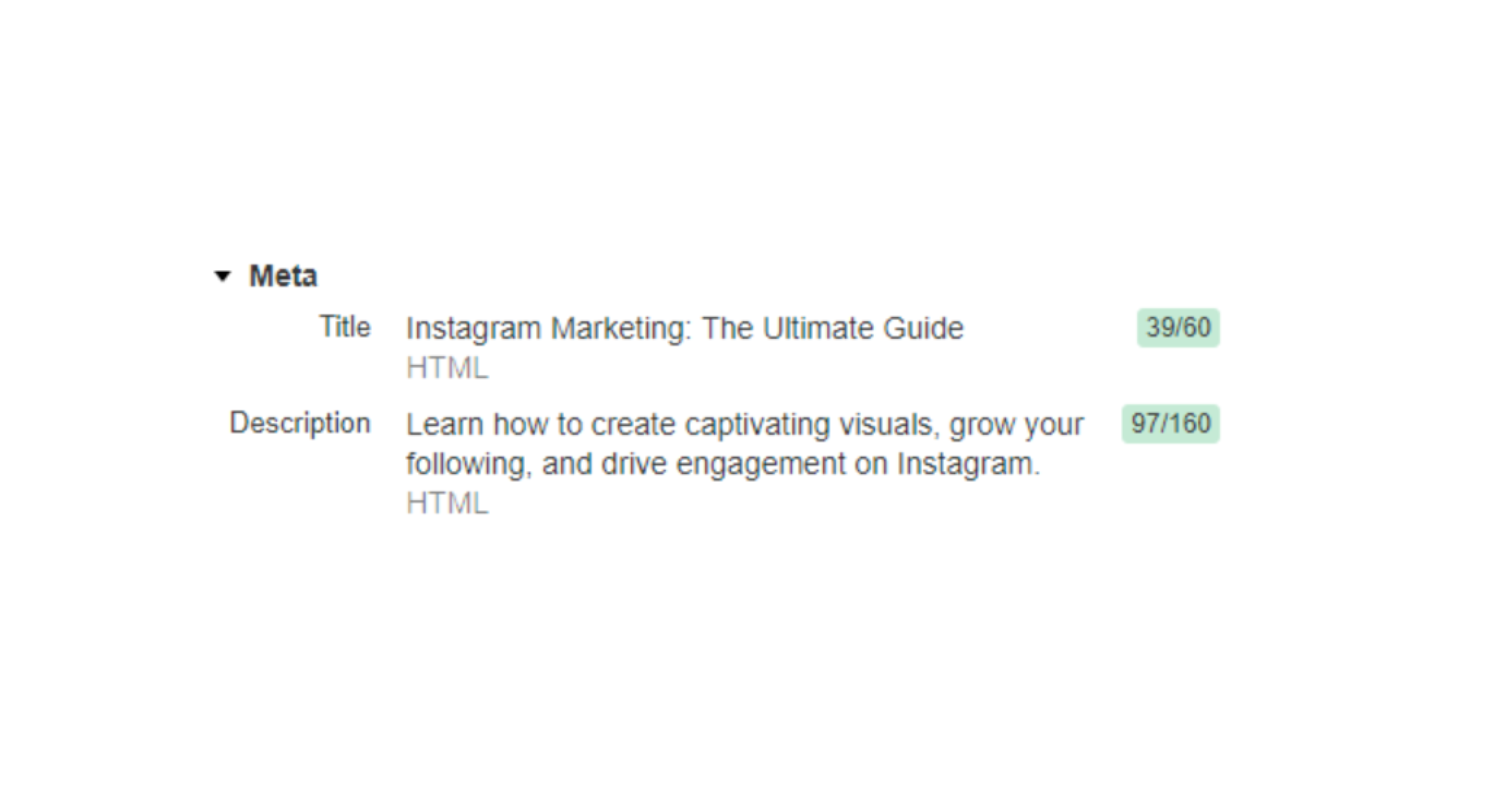
Header Tags
Why: Header tags (H1, H2, H3, etc.) not only make your content skimmable but also give search engines clues about the structure of your content.
How: Your H1 should encapsulate the core topic and include your primary keyword. Subsequent headers (H2, H3, etc.) should logically break down the content into sub-topics, making use of long-tail and LSI keywords where appropriate.
Here is an example of the opening header tag structure:
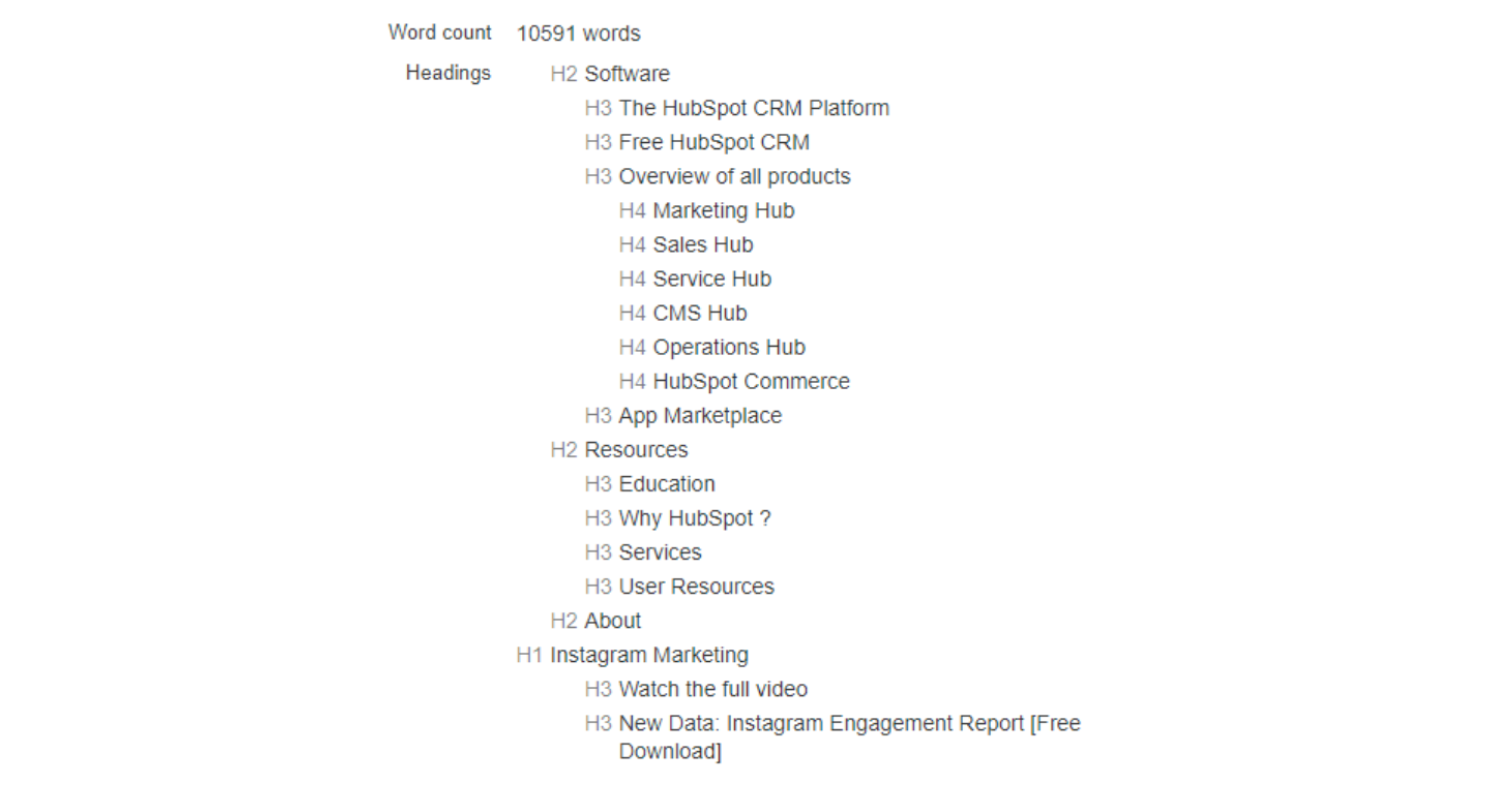
Keyword Placement & Density
Why: Including keywords throughout your content helps search engines understand the topic of the page. However, overuse can lead to penalties.
How: Aim for a balanced keyword density, typically around 1-2%. Use synonyms and variations to avoid keyword stuffing. Prioritise putting keywords in the first 100 words, headers, and conclusion to maximise impact.
Semantic SEO & Contextual Relevance
Why: Search engines are becoming increasingly sophisticated in understanding context. In B2B SaaS, where terminology can get technical, context matters.
How: Use terms and phrases related to your primary keywords to build context. This could include industry jargon, features, or related solutions. Contextually rich content is more likely to satisfy not only search engines but also B2B decision-makers looking for comprehensive solutions.
Snippet Optimisation: strive to format at least one section of your content to fit the criteria for Featured Snippets. This increases the chances of your page appearing at the very top of search results.
User Experience (UX): enhance user experience by leveraging elements like bullet points, numbered lists, images, or infographics to break up large sections of text.
Internal Linking: use internal links to guide the visitor through a journey that aligns with the B2B sales cycle, linking to core pillar pages on use cases, benefits, customer testimonials, and finally, product demos or trials.
6: Mastering Off-Page SEO
Why it Matters:
When it comes to the battleground of SEO, relevance and authority are your twin spears. You've sharpened the spear of relevance with on-page SEO and high-quality content, but what about authority?
That's where off-page SEO, particularly the art and science of backlinks, comes into play.
Backlinks serve as endorsements from other websites, signalling to search engines like Google that your site is relevant but also trustworthy and popular.
The more high-quality backlinks you acquire, the higher your site's authority climbs, making it more likely to rank higher in search results.
7: Boosting Your Backlinks
How to Do It:
Craft a Link Building Strategy
Building backlinks isn't just about quantity; it's about quality. Each backlink acts as a vote of confidence, but not all votes are equal. Search engines look at the quality of the site linking to you, its relevance to your industry, and its overall trustworthiness. As such, you need a well-thought-out strategy that focuses on acquiring high-quality links.
Competitive Analysis: start by studying your highest-ranking competitors’ backlinks. This can provide valuable insights into what kind of backlinks you should aim for and help you discover new platforms or domains you hadn't considered.
Editorial, Organic Links
These are the gold standard of backlinks. They happen when other websites naturally reference your content because it adds value to their posts, guides, or articles. It's organic and incredibly effective for boosting your site's authority.
Content Outreach: regularly reach out to industry blogs, news sites, and other platforms to showcase your high-quality content, encouraging them to reference it.
Guest Blogging
Writing guest posts for reputable industry blogs allows you to tap into their audience and acquire valuable backlinks. But remember, the quality of your guest post will reflect your brand, so make it as top-notch as the content you publish on your own site.
Target and Approach: choose industry-relevant blogs that have a high domain authority. Pitch them with unique content ideas that can provide value to their audience. Always include one or two backlinks naturally within the content or in your author bio.
Industry Partnerships
Forming mutually beneficial partnerships with other industry players can open the door to a host of high-quality backlink opportunities.
Collaborative Content: partner with other industry businesses to create valuable content such as webinars, eBooks, or in-depth articles. Both parties can share this content, providing fresh backlink opportunities for each.
Social Shares
While social media links generally don’t contribute directly to your website’s SEO, a higher rate of sharing can lead to increased visibility, which in turn can lead to more organic backlinks.
Engagement Metrics: monitor the shares, likes, and comments on your social media posts. High engagement can often attract attention from bloggers, journalists, and industry leaders, who may then link back to your content in their work.
You're not just chasing higher search engine rankings by elevating your off-page SEO through a strategic backlink-building approach. You're building a fortress of credibility and authority around your SaaS business, and that's something search algorithms will recognise and reward.
8: Perfecting Your Technical Setup for SEO Excellence
Why it Matters:
The algorithmic wizards that power search engines like Google see the web differently than you and me. To them, your carefully designed, visually stunning website is a set of text blocks, devoid of its aesthetic charm. Because of this disconnect, even if your site appears perfect to human eyes, search engines might find its content utterly inaccessible. Your technical setup, also known as on-site optimisation, acts as a bridge, ensuring that search engines can find, scan, and index your pages accurately and efficiently.
How to Optimise:
Website Navigation and Links:
Search engines find your site and navigate through it in much the same way you'd click through links on a webpage. But remember, unlike you, search engines can't see images, video, or other multimedia elements.
Simple URL Structure:
Your website's URLs need to be straightforward, intuitive, and easily decipherable by search engines.
Keyword-Optimised URLs: make your URLs simple and keyword-rich. The easier they are to read, the better they'll perform in search rankings. Avoid long, complex URLs filled with extraneous information.
Be clear on your URL slugs and make sure you use the correct full terminology for your business or product to help Google rank you for the correct terms. Google Search Advocate John Mueller has confirmed that words in a URL are a ranking factor.
Text-Based Navigation: make your website’s navigation text-based, if possible. This makes it easier for search engines to crawl your site and understand its structure. Dynamic elements like JavaScript-based menus should be avoided or have text alternatives.
Optimise for Speed: compress your images and leverage browser caching to improve your website’s loading speed. Google's Page Speed Insights Tool can give you a comprehensive rundown of what needs to be improved.
Dead Links and Broken Redirects
These issues not only provide a poor user experience but also stop search engine crawlers in their tracks, preventing them from indexing your content.
Regular Audits: use tools like Screaming Frog SEO Spider, SEM Rush or Google's own Search Console to regularly check for dead links and broken redirects. Fix them promptly to ensure smooth crawling and indexing.
Sitemaps and Robots.txt Files
These files guide search engines on what to index and what to ignore.
XML Sitemap: create an XML sitemap listing all the important pages of your site and submit it to search engines. This aids search engines in more efficiently finding, crawling, and indexing your content.
Robots.txt: utilise a Robots.txt file to specify what parts of your website search engines should not crawl. This is particularly useful for hiding non-public pages or other content you don’t want to show up in search results.
9: Creating Great User Experience
Google cares about user experience when it comes to SEO, and so should you. With social search on the rise, Google is working hard to answer the questions a searcher expects to see when they type in a search query. Consider user experience as part of your B2B SEO, like ease of use and a positive experience.
According to Search Engine Journal, the best way to do this is to tell or show the how, what, why, or when of a user's question.
Search engines consider how quickly your page loads as an indicator of its quality and user-friendliness. And so do visitors. Think about it: how often have you left a site because it takes ages to load?
Topic clusters: A great way to organise your site’s content and enhance the user experience is by using the Topic Cluster methodology – we listed it up in step 4.
Nail this effectively, and you are on your way to creating content loved by users and search engines. It’s good practice to write in smaller chunks and use bullet points or lists where possible.
You should also read your content once it’s on your site. Doing this gives you the user's perspective. Ask the questions - Is your content answering the question? Is it pointing to other questions a user hadn’t thought to ask but needed to know? How can you make it better for users and search engines?
Moblie optimisation: over half of all internet searches are made via mobile, and this figure has risen consistently over the years.
Moreover, 60% of smartphone users have contacted a business directly using the ‘call feature’ on Google. And 57% of people won’t recommend a business if it has a badly designed website that causes a poor mobile user experience.
Images: use images where possible, and make sure image files are compressed and alt tags are used.
10: Content Audit and Tackling Duplicate Content
Search engines get baffled by duplicate content, and it could adversely affect your site's ranking or even result in a penalty.
Canonical Tags: use canonical tags to tell search engines which version of a page they should consider as the authoritative one when you have similar or duplicate content across multiple pages.
Content Audits: regularly conduct content audits to identify and remove or consolidate duplicate content.
By paying attention to your site's technical setup, you not only make it easier for search engines to crawl and index your site but also provide a better user experience for your human visitors. And in the SEO arena, being technically sound is half the battle won.
Ready, steady, grow….
The landscape of B2B SaaS marketing is intricate and fiercely competitive. Scaling successfully in this environment requires an agile and data-driven approach to SEO.
From understanding your target audience's pain points to continuously evolving your SEO strategy, each facet plays a critical role in driving business growth.
We've laid out a comprehensive roadmap to guide you through this journey, from content creation to SEO analysis and competitor research.
By implementing these strategies, you’re not just optimising for search engines –you’re establishing a sustainable framework for long-term growth and customer engagement.
Need some help?
Elevate your B2B SaaS marketing to the next level with our expert guidance.
Angelfish Marketing is offering a free SEO Strategy Session and Audit to help you identify gaps in your current strategy, spot opportunities, and map out a tailored action plan for success.
Take advantage of this opportunity to get actionable insights to transform your marketing efforts.
Get your free SEO audit
In today's online-centric world, your website is essential to sales success. And if you want your website to be found, then you need a strong SEO strategy

In-depth review of your website's organic traffic
Technical and on-page SEO review
Backlink profile and competitor analysis
Review of your main competitors' websites


